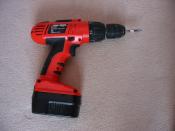D O
N O
T CO PY
Harvard Business School 9-595-057 Rev. March 30, 2001
Professor Robert J. Dolan prepared this case as the basis for class discussion rather than to illustrate either effective or ineffective handling of an administrative situation. Certain non-public data have been disguised.
Copyright © 1995 by the President and Fellows of Harvard College. To order copies or request permission to reproduce materials, call 1-800-545-7685, write Harvard Business School Publishing, Boston, MA 02163, or go to http://www.hbsp.harvard.edu. No part of this publication may be reproduced, stored in a retrieval system, used in a spreadsheet, or transmitted in any form or by any means-electronic, mechanical, photocopying, recording, or otherwise-without the permission of Harvard Business School.
1
The Black & Decker Corporation (A): Power Tools Division
Joe, I like you guys. But, look, I give Makita 10 feet of space. I give you 10 feet of space. They outsell you 8 to 1. What are we going to do about that?
In January 1991, statements like this no longer surprise Joseph Galli. Black & Decker's (B&D) vice president of sales and marketing for power tools had heard similar sentiments expressed by many trade accounts. Makita Electric of Japan had practically taken over the professional power tools for tradesmen business since it entered the United States market a decade ago. "Tradesmen" was one of the three major segments of the power tools business-the others being "Consumer" and "Industrial." "Consumer" represented "at home" use, while both "Tradesmen" and "Industrial" covered professional users. The distinguishing characteristic of the Tradesmen segment was that these buyers, such as a carpenter, bought tools for their own use on a job site. In Industrial, the buyer was generally a corporation purchasing tools for use by employees. By late 1990, Makita's success in the Professional-Tradesmen segment...


